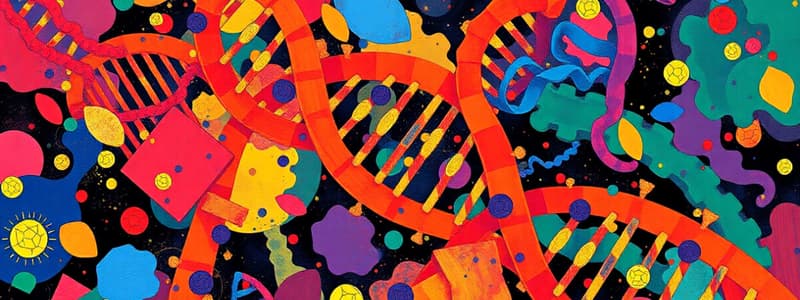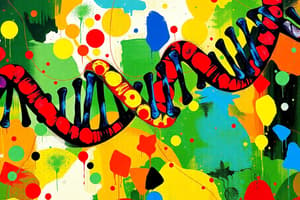Podcast
Questions and Answers
What is the primary enzyme responsible for unwinding the DNA double helix during replication?
What is the primary enzyme responsible for unwinding the DNA double helix during replication?
During transcription, which strand of DNA serves as the template for mRNA synthesis?
During transcription, which strand of DNA serves as the template for mRNA synthesis?
Which of the following is NOT directly involved in the process of translation?
Which of the following is NOT directly involved in the process of translation?
What is the role of aminoacyl-tRNA synthetases in translation?
What is the role of aminoacyl-tRNA synthetases in translation?
Signup and view all the answers
Which of the following events occurs during the termination stage of translation?
Which of the following events occurs during the termination stage of translation?
Signup and view all the answers
What is the primary direction of DNA synthesis during replication?
What is the primary direction of DNA synthesis during replication?
Signup and view all the answers
What role does helicase play in DNA replication?
What role does helicase play in DNA replication?
Signup and view all the answers
Which enzyme is responsible for relieving torsional stress during DNA replication?
Which enzyme is responsible for relieving torsional stress during DNA replication?
Signup and view all the answers
What is the function of RPA protein in DNA replication?
What is the function of RPA protein in DNA replication?
Signup and view all the answers
What is the function of PCNA during DNA replication?
What is the function of PCNA during DNA replication?
Signup and view all the answers
Which characteristic correctly describes DNA polymerases?
Which characteristic correctly describes DNA polymerases?
Signup and view all the answers
Which type of topoisomerase is involved in introducing double-stranded breaks?
Which type of topoisomerase is involved in introducing double-stranded breaks?
Signup and view all the answers
What initiates the synthesis of a new DNA strand during replication?
What initiates the synthesis of a new DNA strand during replication?
Signup and view all the answers
Which of the following proteins is involved in removing RNA primers during DNA replication?
Which of the following proteins is involved in removing RNA primers during DNA replication?
Signup and view all the answers
What is a replicon in the context of DNA replication?
What is a replicon in the context of DNA replication?
Signup and view all the answers
Which statement about the synthesis of the lagging strand is correct?
Which statement about the synthesis of the lagging strand is correct?
Signup and view all the answers
Which DNA polymerase is primarily responsible for synthesizing the leading strand?
Which DNA polymerase is primarily responsible for synthesizing the leading strand?
Signup and view all the answers
What is the primary function of ligase during DNA replication?
What is the primary function of ligase during DNA replication?
Signup and view all the answers
What is the first step in the formation of the pre-replication complex?
What is the first step in the formation of the pre-replication complex?
Signup and view all the answers
The leading strand is synthesized in which direction?
The leading strand is synthesized in which direction?
Signup and view all the answers
What role does topoisomerase play during DNA replication initiation?
What role does topoisomerase play during DNA replication initiation?
Signup and view all the answers
Which polymerase is primarily responsible for synthesizing the new DNA strand on the leading strand?
Which polymerase is primarily responsible for synthesizing the new DNA strand on the leading strand?
Signup and view all the answers
Which enzyme is involved in the removal of RNA primers during lagging strand synthesis?
Which enzyme is involved in the removal of RNA primers during lagging strand synthesis?
Signup and view all the answers
What happens when replication forks meet in eukaryotic DNA replication?
What happens when replication forks meet in eukaryotic DNA replication?
Signup and view all the answers
Which process involves adding a cap to the 5’ end of pre-mRNA?
Which process involves adding a cap to the 5’ end of pre-mRNA?
Signup and view all the answers
What is formed as a result of the uneven synthesis of DNA strands during replication?
What is formed as a result of the uneven synthesis of DNA strands during replication?
Signup and view all the answers
What is the role of the pre-initiation complex in transcription?
What is the role of the pre-initiation complex in transcription?
Signup and view all the answers
Which type of RNA polymerase is involved in synthesizing messenger RNA?
Which type of RNA polymerase is involved in synthesizing messenger RNA?
Signup and view all the answers
During the elongation phase of transcription, what is added to the tail of RNA polymerase II to facilitate its function?
During the elongation phase of transcription, what is added to the tail of RNA polymerase II to facilitate its function?
Signup and view all the answers
Which of the following statements about telomeres is correct?
Which of the following statements about telomeres is correct?
Signup and view all the answers
What occurs at the termination signal for mRNA transcription?
What occurs at the termination signal for mRNA transcription?
Signup and view all the answers
What is the role of the ribosome during translation?
What is the role of the ribosome during translation?
Signup and view all the answers
Which of the following correctly describes the structure of a ribosome?
Which of the following correctly describes the structure of a ribosome?
Signup and view all the answers
What is the first amino acid incorporated into every polypeptide chain during translation?
What is the first amino acid incorporated into every polypeptide chain during translation?
Signup and view all the answers
Which sites are involved in the ribosome's interaction with tRNA during translation?
Which sites are involved in the ribosome's interaction with tRNA during translation?
Signup and view all the answers
What initiates the process of translation?
What initiates the process of translation?
Signup and view all the answers
How does a peptide bond form during translation elongation?
How does a peptide bond form during translation elongation?
Signup and view all the answers
What triggers termination of translation?
What triggers termination of translation?
Signup and view all the answers
What is a primary function of release factors during translation termination?
What is a primary function of release factors during translation termination?
Signup and view all the answers
Which post-translational modification involves adding phosphate groups to a protein?
Which post-translational modification involves adding phosphate groups to a protein?
Signup and view all the answers
Which chaperone protein function is correct?
Which chaperone protein function is correct?
Signup and view all the answers
Which statement is true regarding the initiation of translation?
Which statement is true regarding the initiation of translation?
Signup and view all the answers
How do incorrectly folded proteins typically behave within the cell?
How do incorrectly folded proteins typically behave within the cell?
Signup and view all the answers
During elongation, how does the ribosome progress along the mRNA?
During elongation, how does the ribosome progress along the mRNA?
Signup and view all the answers
Which type of tRNA binds to the P site during the initiation phase of translation?
Which type of tRNA binds to the P site during the initiation phase of translation?
Signup and view all the answers
Flashcards
DNA Replication
DNA Replication
The process of copying DNA to create identical DNA strands.
Transcription
Transcription
The process of synthesizing RNA from a DNA template.
Translation
Translation
The process of synthesizing proteins from mRNA.
mRNA
mRNA
Signup and view all the flashcards
Proteins
Proteins
Signup and view all the flashcards
Mature mRNA
Mature mRNA
Signup and view all the flashcards
Ribosome
Ribosome
Signup and view all the flashcards
Peptide bond
Peptide bond
Signup and view all the flashcards
Initiation of translation
Initiation of translation
Signup and view all the flashcards
fmet-tRNAf
fmet-tRNAf
Signup and view all the flashcards
AUG codon
AUG codon
Signup and view all the flashcards
Elongation stage
Elongation stage
Signup and view all the flashcards
Peptidyl transferase
Peptidyl transferase
Signup and view all the flashcards
Termination of translation
Termination of translation
Signup and view all the flashcards
Post-translational modifications
Post-translational modifications
Signup and view all the flashcards
Chaperone proteins
Chaperone proteins
Signup and view all the flashcards
Phosphorylation
Phosphorylation
Signup and view all the flashcards
STOP codons
STOP codons
Signup and view all the flashcards
Rough endoplasmic reticulum
Rough endoplasmic reticulum
Signup and view all the flashcards
Semiconservative Replication
Semiconservative Replication
Signup and view all the flashcards
Direction of DNA Synthesis
Direction of DNA Synthesis
Signup and view all the flashcards
Phosphodiester Bond
Phosphodiester Bond
Signup and view all the flashcards
Helicase
Helicase
Signup and view all the flashcards
Topoisomerase
Topoisomerase
Signup and view all the flashcards
RFC
RFC
Signup and view all the flashcards
DNA Polymerase
DNA Polymerase
Signup and view all the flashcards
Primase
Primase
Signup and view all the flashcards
Leading and Lagging Strands
Leading and Lagging Strands
Signup and view all the flashcards
Proofreading by DNA Polymerase
Proofreading by DNA Polymerase
Signup and view all the flashcards
RNase H
RNase H
Signup and view all the flashcards
Ligase
Ligase
Signup and view all the flashcards
Stages of DNA Replication
Stages of DNA Replication
Signup and view all the flashcards
Pre-replication complex (pre-RC)
Pre-replication complex (pre-RC)
Signup and view all the flashcards
Origin Recognition Complex (ORC)
Origin Recognition Complex (ORC)
Signup and view all the flashcards
Leading strand
Leading strand
Signup and view all the flashcards
Lagging strand
Lagging strand
Signup and view all the flashcards
Okazaki fragments
Okazaki fragments
Signup and view all the flashcards
Replication forks
Replication forks
Signup and view all the flashcards
Telomeres
Telomeres
Signup and view all the flashcards
Splicing
Splicing
Signup and view all the flashcards
Polyadenylation
Polyadenylation
Signup and view all the flashcards
Transcription factors
Transcription factors
Signup and view all the flashcards
Termination in transcription
Termination in transcription
Signup and view all the flashcards
Study Notes
DNA Replication, Transcription, and Translation
- DNA Replication: A semiconservative process. Each strand of the double helix serves as a template for a new, complementary strand. DNA synthesis proceeds only in the 5' to 3' direction.
- Requires numerous protein complexes and energy input from high-energy phosphate bonds.
- Proteins involved in Replication: Helicase (MCM 2-7), Topoisomerases (I and II), Replication Protein A (RPA), Proliferating Cell Nuclear Antigen (PCNA), Replication Factor C (RFC), DNA Polymerases (α, β, γ, δ, ε), RNase H, FEN1, Ligase.
- Helicase (MCM 2-7): A ring-shaped protein complex that unwinds the DNA double helix. MCM 2-7 proteins hydrolyze ATP to split apart the complementary strands.
- Topoisomerases: Relieve the torsional stress caused by unwinding.
- Replication Protein A (RPA): Binds to single-stranded DNA to prevent it from reforming into a double helix, thus ensuring the availability of a template strand for DNA polymerase.
- Proliferating Cell Nuclear Antigen (PCNA): A ring-shaped protein that acts as a sliding DNA clamp to stabilize DNA polymerases during replication. It protects DNA polymerase from falling off the template strand and releases it after each Okazaki fragment synthesis.
- Replication Factor C (RFC): A ring-shaped protein that loads PCNA onto DNA during replication
- DNA Polymerases: Enzymes responsible for synthesizing new DNA by adding nucleotides to the 3' end of the growing chain.
- RNase H: An enzyme that removes the RNA primer.
- FEN1: An exonuclease that removes the last ribonucleotide of the RNA primer.
- Ligase: An enzyme that joins the Okazaki fragments on the lagging strand.
Limitations of Replication
- The need to unwind the DNA double helix.
- The inability of DNA polymerase to independently initiate the synthesis of a new strand.
- The addition of nucleotides occurs only in the 5' to 3' direction.
Stages of Replication
- Initiation: Recognition of specific DNA sequences (origins of replication) where replication begins. Formation of the pre-replication complex (pre-RC), including ORC, Cdc6, Cdt1, and MCM complexes.
- Elongation: Unwinding of the DNA double helix by helicases; topoisomerase action to relieve stress; RPA to stabilize single-stranded DNA; PCNA to stabilize DNA polymerases; synthesis of both leading and lagging strands, in 5' to 3' direction.
- Termination: Replication forks meet, causing the completion of replication.
Replication Forks
- DNA strands have an antiparallel arrangement.
- Synthesis of the new strand takes place in the 5' to 3' direction, leading to an asymmetric arrangement of replication forks.
- The leading strand is synthesized continuously, while the lagging strand is synthesized in sections called Okazaki fragments.
DNA Polymerases
- Require a DNA template.
- Cannot initiate synthesis independently; need a primer.
- Polymerase activity for DNA synthesis in the 5' to 3' direction.
- Corrective activity (3' to 5' exonuclease activity).
Polymerase a/Primase
- Has both primase and DNA polymerase activity.
- Primase synthesizes a short RNA primer as a starting point for DNA synthesis.
- DNA Polymerase α adds a short stretch of DNA (initiator DNA) to the primer.
Ribonucleases
- Enzymes that hydrolyze phosphodiester bonds in RNA molecules.
- Endoribonucleases cleave RNA molecules internally.
- Exoribonucleases remove nucleotides from the 3' or 5' end of RNA. RNase H and FEN1 are involved in removing RNA primers.
DNA Replication Elongation
- DNA replication on the leading strand:
- Synthesis of RNA primer (primase).
- Synthesis of DNA strand by a-polymerase.
- RFC recognizes and places the PCNA.
- Exchange of a-polymerase for delta-polymerase.
- Synthesis of DNA strand by delta-polymerase. -Hydrolysis of one phosphate bond in deoxynucleotide triphosphate to attach the nucleotide to the DNA strand.
- Hydrolysis of pyrophosphate (PPi) to make the reaction irreversible.
- Replication on the lagging strand:
- Synthesis of subsequent RNA primers by primase.
- Synthesis of subsequent DNA strands by a-polymerase.
- Recognition of the primer-template hybrid by RFC.
- Loading of PCNA.
- Exchange of a-polymerase for ε-polymerase.
- Synthesis of DNA strands by ε-polymerase - creating Okazaki fragments.
- PCNA transfer.
- Removal of iRNA and IDNA fragments.
- Exchange of ε-polymerase for a-polymerase.
DNA Replication Termination
- Occurs when replication forks meet.
- In eukaryotes, replication forks can meet multiple times. Termination has multiple steps such as, encountering a terminal sequence, disintegration of the replication complex, and telomere synthesis. The lagging strand is always shorter than the template. Telomeres minimize strand shortening after each division.
Transcription
- Rewriting genetic information from DNA into RNA.
- Based on the complementarity rule (A-U, C-G).
- DNA strand is read in the 3' to 5' direction.
- RNA is synthesized in the 5' to 3' direction.
- Catalyzed by RNA polymerases (I, II, III).
- RNA polymerase I is in the nucleolus and involved in rRNA transcription.
- RNA polymerase II is in the nucleoplasm and involved in mRNA transcription.
- RNA polymerase III is in the nucleoplasm and involved in tRNA transcription.
- All RNA types are initially synthesized as precursors (pre-rRNA, pre-mRNA, pre-tRNA).
- Undergo various modifications to become functional.
Transcription Stages
- Initiation: Binding of RNA polymerase to the promoter region of DNA. Formation of the pre-initiation complex, involving transcription factors.
- Elongation: RNA polymerase moves along the template DNA strand, synthesizing RNA in the 5' to 3' direction based on the template.
- Termination: RNA polymerase reaches the terminator sequence in DNA, causing the release of RNA polymerase and the newly synthesized RNA molecule.
Initiation of mRNA Transcription
- A complex of proteins recognizes the promoter.
- This complex binds to the promoter, allowing RNA polymerase II to initiate transcription of pre-mRNA.
Elongation of mRNA Transcription
- Most transcription factors detach from DNA.
- Addition of phosphate groups to RNA polymerase II's tail.
- Continuous addition of ribonucleosides in the 5' to 3' direction.
Termination of mRNA Transcription
- RNA polymerase II continues transcription until a termination signal is received.
- Pre-mRNA dissociates from the DNA-RNA hybrid.
- The separated DNA fragment joins back together.
Post-Transcriptional Processing
- Adding a cap to the 5' end of pre-mRNA.
- Cutting out introns and joining exons (splicing).
- Adding a poly-A tail to the 3' end.
Translation
- Synthesizing a polypeptide chain from mRNA.
- Occurs in the cytoplasm.
- Catalyzed by the ribosome. Core process includes: synthesis of a polypeptide chain; formation of peptide bonds between amino acids.
Ribosome Structure
- Made up of two subunits (small and large).
- Composed of proteins and rRNA.
- Subunits connect during translation.
- Small subunit has an mRNA binding site.
- tRNA binding sites (A, P, E).
Translation Stages
- Initiation: Formation of a pre-initiation complex including small ribosomal subunit, initiation factors, and initiator tRNA.
- Elongation: tRNA carrying next amino acid binds to the free A site. Formation of a peptide bond. Ribosome moves along mRNA, and tRNA without amino acid moves to E site.
- Termination: Presence of STOP codons in mRNA. Release factors bind to the STOP codon. Polypeptide chain is released. Ribosome dissociates.
Post-Translational Modifications
- Proteolytic processing: Cleavage of the protein.
- Formation of secondary structure: Formation of α-helices and β-sheets.
- Protein folding: Correct three-dimensional structure important to protein function.
- Other modifications: Phosphorylation, glycosylation, hydroxylation, methylation, and formylation.
- Chaperone proteins: Facilitate correct protein folding. Incorrect folding leads to degradation of the protein.
Studying That Suits You
Use AI to generate personalized quizzes and flashcards to suit your learning preferences.
Related Documents
Description
Test your knowledge on key molecular biology processes, including DNA replication, transcription, and translation. This quiz covers the roles of enzymes, templates, and sequences involved in these crucial biological functions.




